







The Safety First and Mental Well-Being sections in this issue introduce us to the 5 Principles of Human Performance, which forms the foundation of taking safety and well-being to the next level and a step closer to GOAL ZERO.
Up until now, it has often been the case that whenever incidents or accidents are reported, the investigations that follow reveal procedural flaws. These are important as they allow for the identification of what went wrong and what should have been done. However, they do not explain human behaviour, or why human error remains responsible for the vast majority of incidents or accidents. This is where the 5 Principles of Human Performance comes in as these principles provide invaluable insight into how the safety culture on board can be further strengthened, and the top priority of getting home safely can be realized.
Elsewhere in this issue, Technical’s progress update highlights the importance of planning and testing, while the Marine Operations piece submitted by a new contributor, Captain Yashlok Kumar, reveals how weather conditions necessitate the implementation of specific equipment designed to maintain standards of safety. As regards the Crew Department’s article on Cenmar Mumbai, this revisits the challenges created by the pandemic and the valuable lessons learnt from that time.
In many of the other sections there are links to the 5 Principles of Human Performance. For instance, the discouraging remarks made to some of our senior female staff at the time of their entry into the industry is again brought to the fore. Fortunately, their resolve, selfbelief and the Company’s nurturing of ability regardless of gender have allowed them to flourish in positions that were once widely regarded as being beyond the capabilities of women. Similarly, the significance of family support to drive behaviour is brought out in this installment of Nostalgia. Moreover, the Environmental article on the Sea Women of Melanesia, the Culture Corner article, the Bodies of Water section and the amazing Survival at Sea story are all prime examples of how reacting to reef damage, cultural loss, pollution and a dire situation appropriately can result in a desired outcome.
I sincerely hope that you enjoy this issue of Wavelength. If you have any comments, suggestions or questions regarding the contest, please do not hesitate to contact me at contact@wavelength.gr.
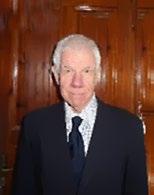
Date
During the second quarter
list of promoted officers and
Company Seafarers were given
together with
details in
appears in the table below.
ASE
SERDUIK Oleskandr
Regardless of the rung reached on the promotional ladder, all the Company Seafarers share admirable traits. Firstly, they have demonstrated commitment to their careers. Secondly, they have shown their loyalty to the Company. Last but not least, they each have a story to tell, as highlighted in the last two installments of Nostalgia. In all likelihood, their stories involve a supportive family
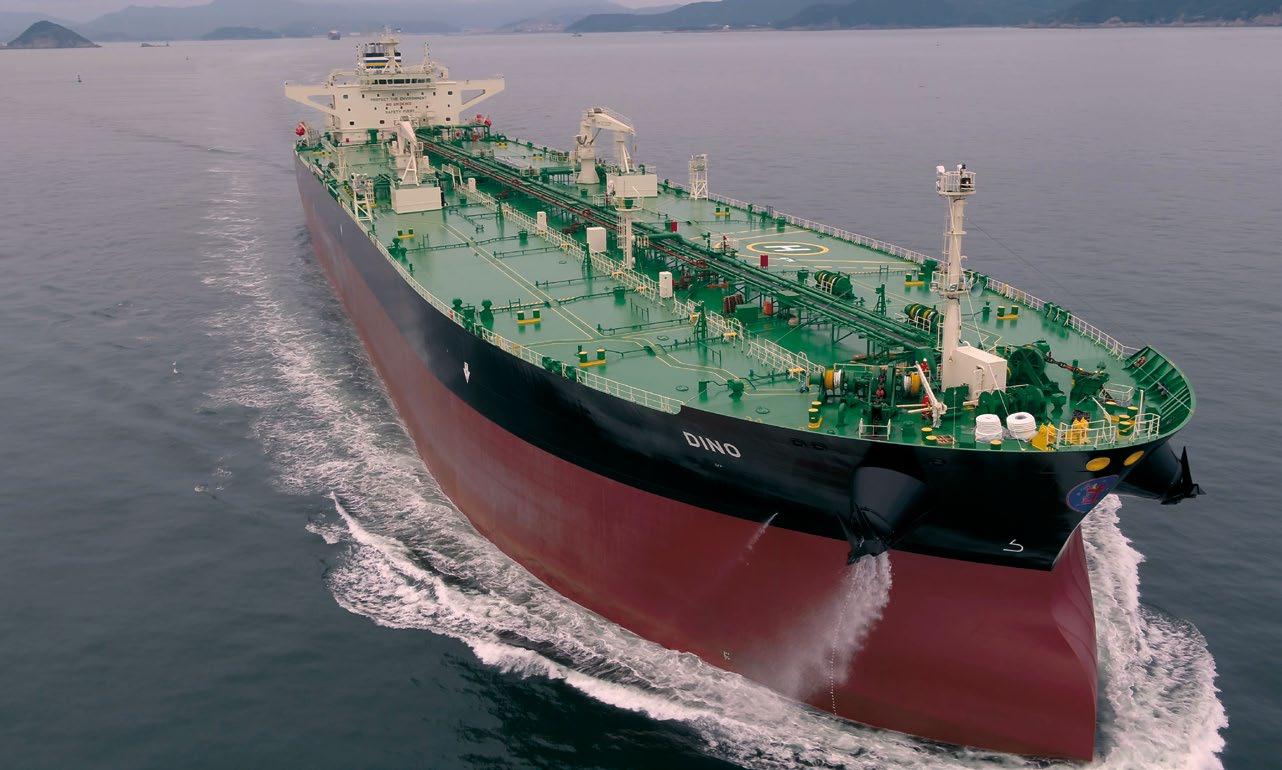
Read
2/E to
and strong bonds that enhance their sense of belonging. These are traits that will stand them in good stead in the future, and allow them to continue successfully on their career paths. All that remains is to congratulate these Company Seafarers on their promotions, and wish them good health and safe returns to their loved ones from their forthcoming voyages.

Approximately one year ago, on 28th July 2021, the steel cutting of the Company’s first project in Samsung Heavy Industries was carried out and marked the official opening of the Site Office in South Korea. On 11th July 2022, we celebrated the delivery of this vessel, M/T DINO, the first of five that has joined the Company’s fleet. Following her, sister vessel M/T AMALIA M also recently joined the Company’s fleet on 7th September 2022. The progress of the work is as follows:
The main events for Hull No. 2419 were carried out on the following dates:
Steel cutting: 28th July 2021

Keel laying: 10th January 2022
Launching: 7th May 2022
Delivery: 11th July 2022
The construction of all the blocks of the vessel was carried out in South Korea and erection work was carried out in Dock No. 2 of Samsung Heavy Industries.




 Figure 1: Keel Laying Ceremony of Hull No. 2419 / Launching of Hull No. 2419
Figure 2: E/R Block erection / Erection of vessel in Dock No. 2
By Christina Toki & Natassa Sakellariou
Figure 1: Keel Laying Ceremony of Hull No. 2419 / Launching of Hull No. 2419
Figure 2: E/R Block erection / Erection of vessel in Dock No. 2
By Christina Toki & Natassa Sakellariou
After launching, the vessel remained alongside and commissioning work began for various pieces of equipment on board. Commissioning was further continued in the Shipyard’s anchorage and during the sea trials that were carried out during the period 24th-28th June 2022.
All the alarms and safety devices of the machinery, equipment and systems, Auxiliary Engines, Auxiliary Boilers, Emergency Generator, Purifiers, Oily Water Separator, Inert Gas System, Ballast Water Treatment System, Gas Detection System, VRC, Cargo & Ballast Pumps, Tank Cleaning Machines & Tank Cleaning Heater, Deck Machinery (Mooring Winches), Emergency Towing System were among the systems which were successfully tested.
During the anchorage period, the inclining experiment and Deadweight measurements at scantling draft (17.2m) were carried out. The results were as follows:

Lightship: 24,673 metric tons
DWT (at 17.2m draft): 157,010 metric tons

During sea trials, the vessel’s speed and maneuverability were verified successfully. The speed measured at the design draft of 16.0m and M/E NCR with 15% sea margin and after the correction to calm sea (no wind, no wave, no current) and deep sea conditions was 14.88 knots. Maneuverability was verified by the Turning Circle, Zig-Zag and Steering gear tests.




The overall performance of the Main Engine (HSD MAN B&W 6G70 ME-C 10.5) was satisfactory and all operating parameters were in accordance with MAN recommendations. The Endurance test of the Main Engine was carried out as follows:
At NCR (68.35% of MCR) for two (2) hours
At MCR (100%) for four (4) hours
Figure 3: Deck foam firefighting system / Tank Cleaning system function testThe daily M/E Fuel Oil consumption at ballast condition and M/E NCR, measured during sea trials for reference, was 34.2 tons/day.
Also, the Main Engine was successfully tested at Tier III mode by running the Low Pressure Selective Catalytic Reduction System (LP SCR), and the NOx emission reduction rate was measured at 86.6%.



Right after the completion of sea trials, the loads of fwd stern tube bearing, intermediate shaft bearing and the three (3) aftmost M/E main bearings were measured in hot condition. The M/E crankshaft deflection and the top clearances of main bearings were measured in hot condition and found in accordance with MAN recommendations.
Vibration and noise level measurements were performed in Accommodation spaces, the Wheelhouse, Engine Room and other working areas, where low levels were indicated.

Following the rectification of all the points raised during sea trials by Samsung Heavy Industries, M/T DINO was successfully delivered to the Owners on 11th July 2022.
A Crash Stop Astern test was also carried out to prove that the Main Engine is capable of achieving the ship’s emergency stop.
The time and sailing distance between “Order of astern under headway” and “Ship’s stop” were measured as follows:
Time: 12 minutes and 22 seconds
Sailing distance: 2,849m

The vessel has been assigned the ESA Notation (Enhanced Shaft Alignment) and the new triple slope design of the aft stern tube bearing has been applied. Therefore, a running-in procedure for the aft stern tube bearing was followed at the commencement of sea trials.
M/E has operated at “slow”, “half”, “full” and “navigation full” while the rudder angle was kept at 5°, 15° and 25° (port & starboard) at each of the above mentioned M/E loads (for a period of 5 minutes at each of the above conditions).
The average temperatures measured indicated normal conditions and no white metal was found in the stern tube L.O. pumps filter, which were opened up on completion of the running-in.
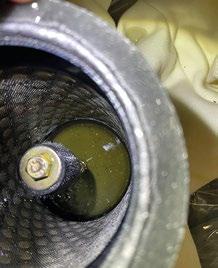
The main events for Hull No. 2420 were carried out on the following dates:
Steel cutting: 15th September 2021


Keel laying: 21st March 2022
Launching: 1st July 2022
Delivery: 7th September 2022
The construction of the blocks of the vessel was mainly carried out in South Korea with the exception of the Engine Casing giga block that was constructed in Rongcheng Shipyard in China. Erection work was carried out in Dock No. 2 of Samsung Heavy Industries.



The vessel successfully completed her sea trials during the period 17th-20th August.
The results of the sea trials tests were similar to those of Hull No. 2419 and all the points raised in the comments were rectified on time.
Figure 6: Main Engine Figure 7: Main Engine LP SCR Control Panel and Burner Unit Figure 8: Vessel's route on ECDIS during running-in / Stern tube L.O. filter condition Figure 9: M/T DINO during sail away from Samsung Heavy Industries Figure 10: Engine Casing block transferred to Shipyard / Erection work in Dock No. 2For the celebration of the delivery of M/T DINO and M/T AMALIA M, the naming ceremony of both vessels was carried out on 6th July 2022 in Geoje, South Korea. It was attended by the Owners, Samsung Heavy Industries and ABS Management.

The steel cutting of both projects was completed as follows: Hull No. 2440 – 18th February 2022 Hull No. 2441 – 12th April 2022


The steel fabrication and assembly was fully completed for Hull No. 2440 and pre-erection work started in August 2022, while all the fabrication and assembly work for Hull No. 2441 are still in progress.

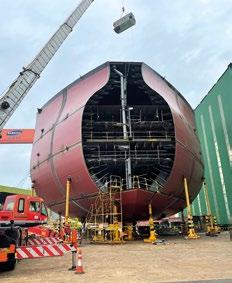
The blocks, outfitting and painting work are under inspection by the Site Office team and delivery of the vessels to the Owners is expected in mid-February 2023 for Hull No. 2440 and late March 2023 for Hull No. 2441.
The following main events for Hull No. 2421 have been completed so far:
Steel cutting: 29th December 2021 Keel laying: 4th July 2022
At the moment, the tandem block is being erected in Dock No. 2 and tandem launching is scheduled for 4th September 2022.

All steel fabrication and assembly have been completed in South Korea except one part completed in Rongcheng, China. Erection progress is at 60% and upon tandem launching, the erection of the giga and mega blocks will commence in Dock No. 2.

Delivery of the vessel to the Owners is expected in early January 2023.

To be continued…


From our Site Office, we are sending our warmest wishes to the newly delivered vessels M/T DINO and M/T AMALIA M and we wish them and their crew safe and prosperous voyages.
With regards to the following projects, we are focusing our efforts on the continuous inspections taking place and we are looking forward to welcoming our seafarers in South Korea for the sea trials and delivery of upcoming vessels.
Delivery to the Owners was carried out on 7th September 2022. Figure 12: Naming ceremony of M/T DINO and M/T AMALIA M Figure 13: Part of tandem block / Giga block in erection stage Figure 14: Blocks under construction Figure 15: Blasting and painting work (stripe coats)According to SOLAS regulations, a lifeboat can be designated as a rescue boat provided that its launching and recovery arrangements comply with the requirements for a rescue boat. A lifeboat is a survival craft used for sustaining the lives of persons in distress from the time of abandoning ship, while a rescue boat is used to rescue a person in distress (overboard) and take that person to board the ship.
A ship’s crew must be fully familiar with the launching and recovering of the lifeboat which is designated as a rescue boat. Regular lifeboat drills and the attained hands-on experience of the launching and picking up of the rescue boat keep the ship’s crew well trained and familiar with the practical aspects of this very important lifesaving operation.
SOLAS requires that “Rescue boat launching appliances shall be provided with foul weather recovery strops for recovery where heavy fall blocks constitute a danger”. Ships are provided with a ‘Foul weather recovery arrangement’ in the form of recovery strops when the distance between the fall blocks and the lifeboat hooks is less than 2 metres. The use of the recovery strops ensures that the lifeboat’s fall blocks will not cause any injury to the crew member who is connecting the hooks during foul weather.

The arrangement and use of the recovery strops is laid out in the SOLAS training manual.
Crew members must be fully aware of the importance and use of the recovery strops. Every drill involving the lowering of a lifeboat into the water is not complete without the use of the recovery strops. Regular training ensures visualization and familiarization of the procedure of recovery strops deployment. Henceforth, these important emergency rigging parts will not be ignored and will be put to proper use at a time of need.
With the aim of helping crew members to understand the procedure of the deployment of recovery strops, a demonstration of foul weather recovery was carried out during the last lifeboat drill.
Prior to lowering the lifeboat/rescue boat, one end of the approved heavy weather recovery strops was connected to the middle link of the chain which connects the fall block to the lifeboat hook. (The design of this strop varies from vessel to vessel, but it is always made of rope material).
Hanging off pendants connected to the davit arms prior to the lowering of the boat. In the photograph, the wires hang freely as the davit is lowered.

Note: Ensure all components are approved prior to use and the SWL as per the manual
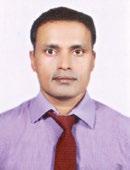
One end of the hanging off pendant was connected to the lug provided on the davit arm. The boat was then boarded by the crew members, lowered and maneuvered in the water; sprinklers and other equipment were tried out as usual. Thereafter, the boat was maneuvered back into position to be picked up.
The hooks were then reset and instead of connecting the lifeboats to the usual suspension links, the ‘heavy weather strops’ were hooked. The lifeboat was then gently lifted a few metres above the water level and all the crew members witnessed first-hand the process of how a rescue boat can be recovered with ‘foul weather recovery strops’.
Notice how the block is well clear of the porthole of the boat at this position. During foul weather, it remains clear of the persons hooking the boat.

The lifeboat was then lowered back into the water and the foul weather strops removed and the normal suspension links connected. This step is not carried out during an actual heavy weather recovery. During the heavy weather recovery the boat is lifted all the way up to the level of the hanging off pendants
Once the lifeboat was up to the level of the hanging off pendants, they were connected to the two lugs on the lifeboat hook, provided for this purpose. Now the boat can be gently lowered again and the weight transferred from the ‘recovery strop’ to the hanging off pendant. (In our case, from the suspension links.)
The weight of the lifeboat is transferred to the hanging off pendants . The ‘ foul weather strops’ are now free to be removed from the hook and connected back to the ‘suspension link’.


At this moment, the weight of the lifeboat is completely off the hook and on the maintenance lug on the hook. This was demonstrated to the crew. In an actual scenario the recovery strops are removed from the hook and suspension links are connected to the hook. The boat was then slowly lifted again and the weight transferred from the hanging off pendant back to the suspension links. The boat was then finally hauled up back into the stowage position.
The onboard personnel fully comprehended the uses of the ‘foul weather recovery strop’ and ‘hanging off pendant’ during the drill.
Heavy weather recovery of lifeboat is an important process which is susceptible to fatal errors, especially if the process in not carried out correctly or if the equipment is not regularly tried out. During this training session, the crew members tackled the issues that can be encountered during this process, the challenges that exist and the kind of team work that is required to pull it off smoothly. If it had just been reading from a book or a training manual, these valuable lessons could not have been acquired. The heavy weather recovery process is a very good practice that can be conducted during the three-monthly life boat maneuvering drill. Wishing you calm seas & safe voyages


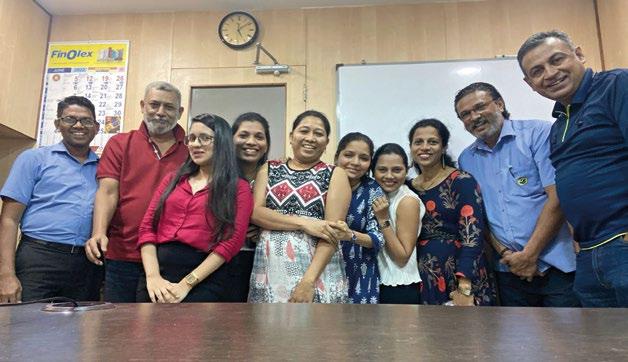
In recent years, many new challenges have been met by our manning offices. During the covid pandemic, manning offices had to work continuously under additional workload and much more demanding circumstances. Travelling to and from office at the peak of the pandemic, arranging the travel schedules of seafarers after meeting a series of new requirements (additional Covid tests, booking hotel rooms for isolation, issuing instructions for proper isolation, meeting the requirements of several immigration departments of the countries abroad for the travelling crew) were challenges which were unknown in the past, but were all fulfilled in the best possible way by all the Cenmar staff.
In addition to the above, this year the war in Ukraine has introduced another issue for the manning activities. Again, Cenmar India, working with consistency and dedication, managed to meet all the Company requirements and to achieve the goals.
Acknowledging all the difficulties faced, a special thanks is

As a continuation of the IMO’s inaugural International Day for Women in Maritime, here are some further reflections, observations and experiences of four more of the Company’s senior female shore staff relating to their time in shipping. Once again, they highlight how significant a contribution they have made to both the Company and to the industry as a whole.
Elli Moretti SQE Manager and DPAMy father, whom I lost few months ago, was a doctor. I always looked up to him and wanted to follow in his footsteps. When I finished school and it was time to decide on my studies, I had a discussion with him as always. I was expecting his enthusiasm on my decision to become a doctor, but I sensed that was not the case. He did not want to disappoint me so he appeared agreeable, but something was bothering me. After some time he admitted that he feared I might struggle to become a doctor, spend my years studying and never be content. As a counter proposal he asked himself: which is the industry that has always thrived in Greece?
There was one answer: Shipping. We did a bit of research and I went to study shipping in London. How clever he turned out to be! When I started learning about ships, it was love at first sight!
After my shipping studies, I came back to Athens to look for a job. The timing was perfect. During the ‘90s, there were very few shipping-oriented graduates in the job market. Most shore based personnel were people with seagoing experience. Having a degree in shipping back then was so rare that after sending my CV to five shipping companies, they all wanted to hire me.
This was when I got lucky and got an interview with the late George Stavrakis who persuaded me this Company was the right choice for me. He was also so insightful!
What I mean by being lucky can be summed up in not one, but three areas:
1. Very few women back then were pursuing a career in shipping. Being surrounded mostly by older, male colleagues it was not very easy to be taken seriously. I had to work twice as hard to earn their respect. But I was always surrounded by good people who wanted to pass on their expertise.
2. I chose a Company where the management supported young people, irrespective of their gender. The Company was also growing at the time and shared a culture of enthusiasm for new beginnings by creating a family like environment.
3. Most of us who have been nurtured in this environment are still together trying to do the same for our younger employees and crew members. Interacting with young men and women on an equal basis is what keeps us going and makes us come to the office every day with never ending enthusiasm. Young men and women are the future!
If I had to fit all my years in shipping in one sentence, I would say that Safety has become my lifelong passion both at work and at home. After all, Safety Culture is Gender-blind!
“The main challenge of maritime industry is unpredictability. Thus, the most important aspect of my job is to keep the balance between different opinions and circumstances. We are working with crew changes all over the world and have to be aware of every single requirement and specific rule. For me it’s not just a job; it’s a way of life. We don’t treat our crew just like employees, we listen to every person, and every situation is considered separately. Since the war in Ukraine broke out, our job has gained even more significance as we are helping and supporting the most essential need of human beings – their safety. All of us lost our usual lives in Ukraine, some of our Seamen faced destruction, fear, missing family members and even death. But we are here for them, we are taking care of our Seamen and their families, we are doing our best for their comfort and helping in all possible ways. Right now the performance of our crew on board is the result of a huge effort and understanding by the Company – this involvement is my biggest motivation..”
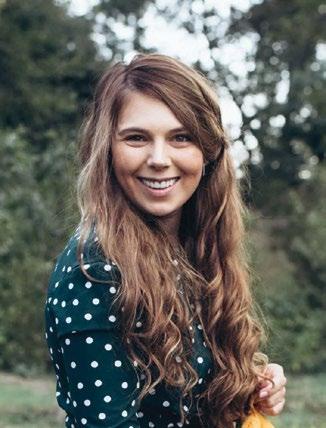
“Odessa is a city of seamen, and my family is not an exception. My father is a seaman, so that is how my involvement in the maritime industry started. I tried various options after my graduation from the National Maritime University of Odessa, and in 2016 I became a member of a big family of Cenmar.
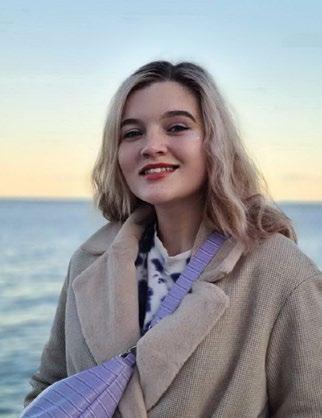
My main task is to look for new crew members, to communicate with seamen and my Company. Here I feel the most comfortable and confident. Exactly this part of my work gives all concerned parties what they need, i.e. the seaman get a stable company and a job, and my Company gets a new reliable worker.
The turning point in my work came at the end of February 2022 when the war broke out in Ukraine. We had to immerse ourselves into new working conditions out of our hometown – out of our comfort zone. But thanks to the support of our Company and our friendly team at Cenmar Ukraine, we managed and are able to move and develop further. Our team is so close that we are living together as a real family now, sharing our ups and downs. We believe that support and mutual assistance of the Company, the team, seamen and their families together is a stable foundation for our teamwork, and for the achievement of our new work objectives.”
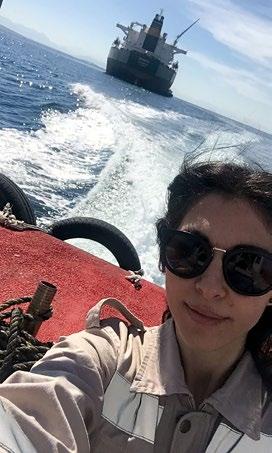
I definitely don’t want to give away my age, but I was about 4 years old when I boarded a tanker for the very first time, back in the early 80s.
Can't remember many details, but I can easily recall that strange smell and the feel of the hot surface of the deck.
Growing up, I felt at home on "my father's vessel" - at least that’s what I thought it was back then – as it turned into my real "home" for a couple of months every year! I spent Christmas and the summer holidays on board as a kid, gaining amazing experiences and meeting remarkable persons, so I had no other choice but to love ships! I might have been just a little girl, but the tugs, the mooring lines, the discussions in the room with many buttons, the huge machines in the noisy and hot room, and the view of the ocean behind the bridge windows (even if I had to climb on a chair to be able to see outside) were imprinted in my mind and heart.
After finishing high school 26 years ago I had to find a job, and that was the time our Company, or to be more precise our family, welcomed me.
Back in the beginning, working in the office had nothing to do with my "onboard" experience! I was no longer the "Master's daughter", looked after by everyone like the ship’s mascot, but a young lady that was trying hard to learn, do well, and survive in a male-dominated field, which was so demanding but so exciting at the same time!
Over the years with the support and nurturing of my colleagues (whom I call "teachers"), and with dedication, passion and a lot of very hard work, I was given the privilege and responsibility to become the Marine Operations Supervisor for our Suezmax Fleet!
I remember during my early days as an operator, while attending a work related event somebody said that our Company was very brave to have a woman operating vessels.
At that moment, I realized two things. The first one was how lucky I was that I was working in a Company that supports, gives space and opportunities to women, and secondly, how hard I needed to keep working to become a part of the change I wanted to see.
All these years I have kept in my heart and mind much of my father's advice, but it is my mother's words that became my motto at work until today.
When I proudly announced my promotion, she said: "From now on every day you need to act and take decisions as if your father or your son is sailing onboard the vessels you are handling". This is exactly what I’ve been trying to do ever since.
Working with amazing people onboard and ashore, some of whom became my family, friends and all of them my teachers, makes me feel blessed.
Shipping is indeed a very demanding, challenging and sometimes tricky field, but it is full of experiences, knowledge, wisdom with one common goal that joins us all working in it - to continue supporting the global supply chain, while keeping our people safe and happy!
In this issue, I would like to say few words about one of the 5 Human Performance Principles (5 HPP): “How I respond to failure matters”.
In our maritime business many unforeseen issues could arise at any given moment. Sometimes these issues could be real problems, like unexpected failures or even accidents. So, when I suddenly get negative information from my colleagues, how am I supposed to react? Should I start shouting? Should I freeze and pass on the responsibility to someone else? Should I start blaming people for not doing their job correctly?
What good would my negative reaction do?
I surely cannot get to the bottom of any problem if people are afraid to tell me the truth because I might overreact to bad news.
I cannot turn back time; what’s done, is done. If I try to remain calm, people will for sure become more open to me. If I am polite and encouraging, people may be motivated to try harder to identify what went wrong. And most importantly, if I am kind even through tough times, maybe I can help someone realize a problem they didn’t even know existed.
Such behaviour is not only relevant to our work but to our everyday life with our friends and family.
If I don’t try to improve my reaction to failure a little more each day, then for sure it means that I will fail both at work and at home.

Remember: In times of failure never ask WHO. Ask WHAT went wrong.
I hope I’ve managed to pass on a valuable message.
I wish you safe voyages and safe return home, Elli Moretti

PS. You can see more about the 5 HPP in our Mental Well Being section of this issue titled “Context Drives Behaviour” (pages 14 & 15)
Often incidents are blamed on people and this gives the impression that people cause incidents. However, most mistakes, actions and decisions result from the way the workplace is set up, how the work is designed, the type of equipment and control measures being used and how leaders influence the culture of an organisation.
It is the people on ships who make safety work. However, unintended human error still occurs.

Human Performance is a term which accepts that people are all different, and that including people in a task creates variability. This variability is intended to allow people to make small adjustments to prevent accidents occurring. People are not machines and will make mistakes, despite being well trained and experienced in their role.

In accepting that mistakes are normal, we should look more at the influence of leadership and ship design to reduce the likelihood of things going wrong.
We should also think about designing the work such that when a mistake happens the outcome is that people “fail safely” and cannot be seriously injured.
Dear seafarers, from the SQE Department Elli Morettia) Source IMT CLIP # 02-2022: IMT have observed a series of Incidents related
b) Source NEPI: An article on snap back zones
There have been a number of recent mooring related incidents that have resulted in vessels breaking away as a consequence of mooring failure and had the potential to cause serious injuries to personnel or fatalities.
• While alongside awaiting hose connection, a vessel experienced stronger than anticipated currents at the berth which led to the failure of multiple mooring lines. As a result, the vessel broke away from the berth and subsequently ran aground.
• While altering course in adverse weather conditions with STS operations under way, both vessels suffered multiple mooring lines failure, which resulted in the vessels separating.
• While making fast a tug utilising the vessel’s messenger line, the tug line got caught on the tug’s winch and resulted in a sudden increase in tension on the messenger line, causing it to part. The resultant snap-back of the messenger line injured the attending vessel officer.
Language barrier - Weather conditions & limitations - Condition of equipment & layout - Failure to tend moorings in a timely manner - Lines under tension - Large tidal variation & Strong tidal streams - Unsheltered sea berth - Passing traffic at high speeds - M/E usage delays - Standby tugs notice period - Manning levels on the Bridge during STS operations
If a mooring-line breaks under load, the sudden release of energy will cause the two broken ends of the line to recoil or ‘snap back’ at high speed and with great force. Anyone standing in the snap-back zone is at risk of serious injury or even death.

In the 2015 edition of the COSWP, under section 26.3.2: “Owing to the design of mooring decks, the entire area should be considered a potential snap- back zone. All crew working on a mooring deck should be made aware of this with clear visible signage”
And under section 26.3.3:
“The painting of snap-back zones on mooring decks should be avoided because they may give a false sense of security”.
Potential snap-back zones should be discussed and identified during a toolbox talk before every mooring operation, but not permanently marked or painted.
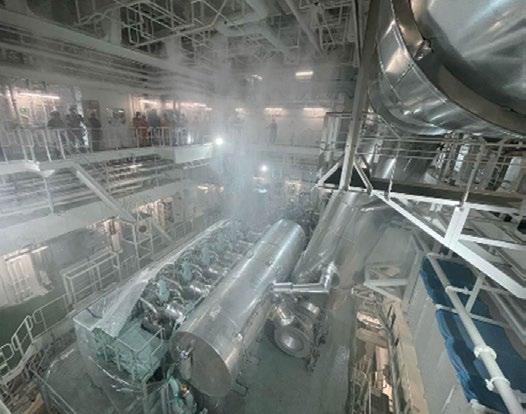
1. Garbage/Oily rags: Oily rags are a serious Fire Hazard. Properly discard them immediately after use.
2. Working at heights: This is common when working in the E/R. Never neglect to take proper safety measures such as wearing a safety harness.
3. Safe Working Loads: When transporting heavy objects in the E/R by using ropes, chains, cranes etc. ensure that the weight of the components does not exceed their lifting capacity.
4. Bilges and alarms: Never bypass an alarm!
5. Insulation: There are many hot surfaces in the E/R. Well maintained insulation is essential.
6. Wiring and electrical: High voltage hazards exist in the E/R. Never leave cables exposed. Properly secure any electrical panels.
7. Panels: Mark properly and secure the area of any missing panels.
8. Lighting: A well-lit E/R is a safe one!
9. Escape exits: They should never be locked!
10. E/R doors: They should never be locked!
Water mist test on Main Engine. Photo from M/T Amalia M, sea trialsOur Company has been participating in the Partners in Safety ((PinS) Programme initiated by Shell for the past 5 years. Currently the programme is focusing on Human Performance, Behaviour and Mental Well-Being. The PinS programme has shifted its attention to the 5 Principles of Human Performance:
By Chara Markatzinou• “Human error is normal”: Error is an unintentional deviation from an expected outcome. We are all prone to making mistakes and we must accept that. We must understand that errors are an opportunity to learn and improve.
• “Blame fixes nothing”: Blame, which is another natural human response, is emotionally but not operationally important. Finding blame does not lead to improvement.
• “Learning and improving is vital”: Learning may be the most powerful safety and reliability tool we have. Learning is improving. Learning and improving are how we grow,
mature and build confidence. You can blame and punish, or you can learn and improve. You cannot do both.
• “Context drives behaviour”: The environment in which work occurs mainly determines workers’ behaviour and actions.

• “How you respond to failure matters”: A leader/manager/ supervisor shapes how the organization learns by its reaction to failure, by getting caught doing things right!
In this article, we will focus on the fourth principle, that of Context driving Behaviour, and we will see how this is related to recreational activities on board the vessel.
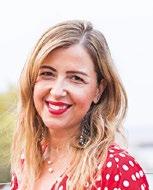
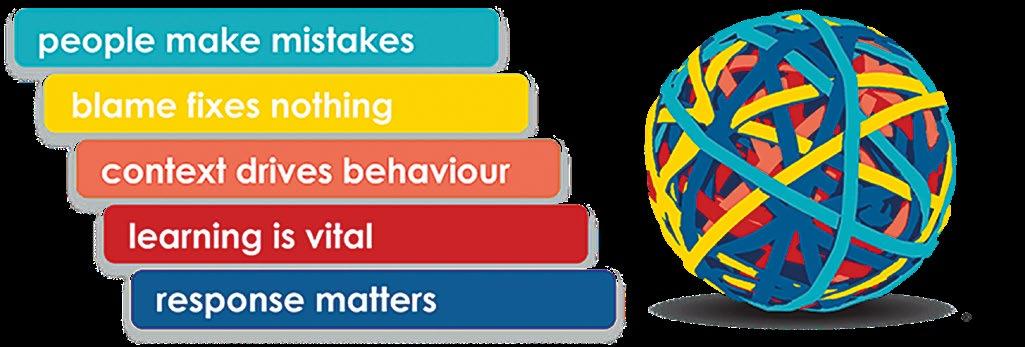
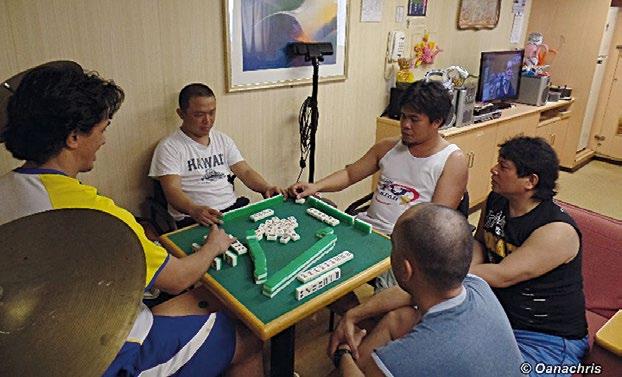
Similarly, the context of vessel life is driven by her leaders’ behaviour and example. It is driven by the way in which the Master, Chief Engineer, the Head Office managers and superintendents follow and exercise safety, and how open they are to their subordinates, making them feel free to communicate not only the “good” or “green” or “easy” but also the “bad” or “red” or “difficult” parts. Moreover, it is shaped by how they admit to their own mistakes and learn from them, how they accept responsibility rather than shifting the blame, how resilient they are, and how curious, smart and humble they can be.
In order to understand in simple words how context drives behaviour, let us consider the following: airports, amusement parks, and highways, to name a few. We learned a long time ago the way to control behaviour is to control the system in which behaviours occur. The driving speed can be slowed down by making the road narrower, which restricts one’s ability to feel as if they have a limitless, open road ahead. If one feels restricted by the system, they behave as if they are in a restricted system. Alternatively, consider how Disneyland figured out that they could get a lot of people to wait two hours for a 40-second ride and get off feeling happy. This is not a function of behavioral choice, because one wouldn't be happy to wait 40 minutes to ride a 40-second ride. That is a function of really building context, where the entire time one is queuing, expectation increases and excitement is created in order to deliver the payoff in the end.
It is the same context in which there is a guarantee that safety is always exercised and followed, and that the well-being of its members is also provided for. We have stressed the importance of our Seamen’s well-being – both physical and mental – so that they
perform to the best of their ability and most importantly, get back home safe and sound. One of the pillars of well-being is recreational activities, which rejuvenate the Seamen, make them feel relaxed and keep their spirits high.
Our Company has always provided equipment for leisure activities on board, including sports and gym equipment, board games, karaoke, book reading as well as photo competitions. It has always encouraged our Seafarers to use such equipment and has replaced items that are no longer functional. As basketball is one of the most popular activities our Seamen enjoy on board as well as ashore, during our Officers’ Forums, equipment for this sport is often found on board. Whenever it is lacking, as was the case during a Leadership visit by our Fleet Supervisor, Mr. A. Chandris, on board M/V Casta Diva in Piraeus in August 2022, a request
can be made freely. A request for a basketball hoop and basketball was made in this instance, and these were immediately supplied prior to the vessel’s departure from Piraeus.

Leisure time and how this is spent is dependent on culture and individual preferences. A 2019 study on recreational possibilities for seafarers concluded that they do not indulge in physical activities due to lack of time, interest and energy. Lack of time and energy are easily understandable if we consider the workload our Seafarers are engaged in. It is the lack of interest we should focus on to understand why Seafarers refrain from engaging in recreational activities. To this end, you will be receiving shortly a questionnaire to fill in, addressing Seafarers’ favourite onboard leisure activities so as to plan our next H&S campaign dedicated to leisure accordingly. Your active contribution will be highly appreciated.
Many quotes about positive thinking can help brighten your day. Even when it seems nothing can go right, these quotes can serve as a reminder that not everything is bad. There is good in each moment, you simply have to look for it.
Life doesn’t always go as planned and it isn’t always perfect. This is normal, and life is supposed to be this way, as you will learn from these quotes about positive thinking. There are always challenges and obstacles to overcome, but you can make the most of it.
From now on, in our Mental Well-Being section we will include a quote that can brighten your day!

Welcome to this second installment of Nostalgia inspired by the words: “Shipping runs in our Family”. In the first installment each and every one of the pieces told a story that came from the heart. Although they gave different perspectives, they all revealed the importance of family not only in terms of a support network but also as a unit that provides a sense of belonging, which is fundamental to the human condition. This extends to being a Seaman with a Company that is committed to functioning as a caring family would.
The stories in this installment are just as insightful and touching as those you have already read. I am sure you will enjoy reading them and those that are to follow in the next issue of Wavelength.
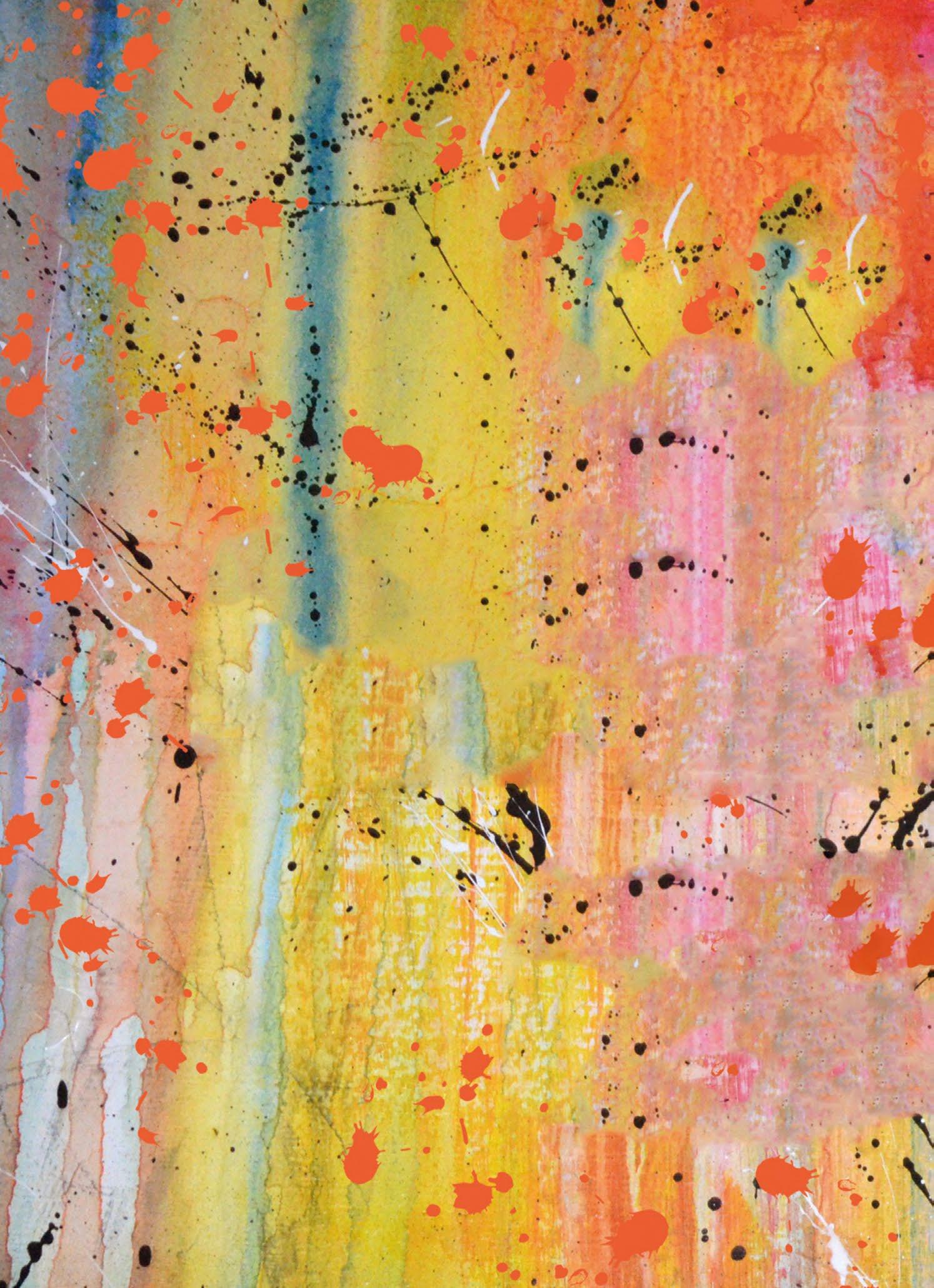
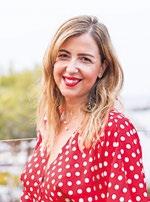
A common question that we have all been asked when we were children was ''WHAT WOULD YOU LIKE TO DO WHEN YOU GROW UP?'' It was simple for me. I wanted to be an air hostess. I loved planes, travelling, meeting people from different nationalities, and getting to know different cultures. However, this remained a dream. Still, I do not regret this dream not turning into reality for the simple reason that I ''fell in love'' with the shipping industry. Who motivated me to switch, from looking up into the sky to diving into the seas? My father, George. He was born in Piraeus, Greece’s biggest port. He graduated from Piraeus University after studying economics and immediately thereafter, was employed by Kat-Efshipping, managing two bulk carriers at the time. Being employed by a small company, he used to do a bit of everything, so he got an overall picture of the shipping industry and how it works. He ended up being a Crew Manager and, as such, was involved in daily discussions with Captains regarding onboard issues among crew members, sick days, etc. His working life became part of our family life, since back then there were no mobile phones and the home landline would ring quite often AOH or during the weekends.
I remember myself sitting close to him and listening to the conversations, trying to understand the issues involved, the cultures of the crew members, the difficulties faced. It was fascinating. I was 15 years old, when I first went to work for two weeks in his office during my summer break as his “assistant''. I did not do much, but this ''office world'', really amazed me. It was a place, where you could not find a moment of peace or feel bored. New challenges kept coming up, difficult problems had to be faced, and communication with the crew, their families as well as other external colleagues was continuous. It was so interesting that one could never stop learning from it. Until my graduation, I went to my Dad’s office every summer for two weeks and when I reached my last year at school I was determined that Shipping would be my field! When I told him, he was a bit thoughtful, saying that this was a ''man's world'', not proper for a woman that wanted to have a family. At the same time he knew I was very determined, having a powerful personality with a strong social touch. So, he simply told me to follow that career path, but advised me to work hard and be very patient in order to succeed. I am extremely proud to be a part of this community and I thank my Dad for showing me the path to do so!
I am Oleksandr Stryzhov, the son of Captain Volodymyr Stryzhov. My father has been my role model all my life. He devoted his whole life to this demanding profession. He started working in our Company in 2000. In June 2002 he became the Captain on M/T Kapsali. He was professional in his job and trained many officers in our Company. I have been proud of him all my life and, therefore, I did not have any other option on which profession to choose. Also, my grandfather was a Navy officer, so my family is actually a Seamen’s family. I had to continue the family profession and tradition. I started working in our Company as a cadet in 2008 and my first vessel was M/T "CEExpress". Since then I have matured and my loyalty to our Company has grown. I am very proud to work here. I hope I will acquire my father’s knowledge and experience one day.
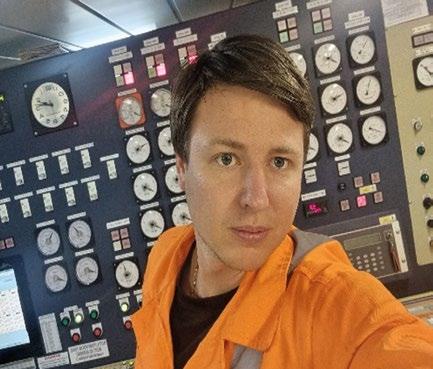
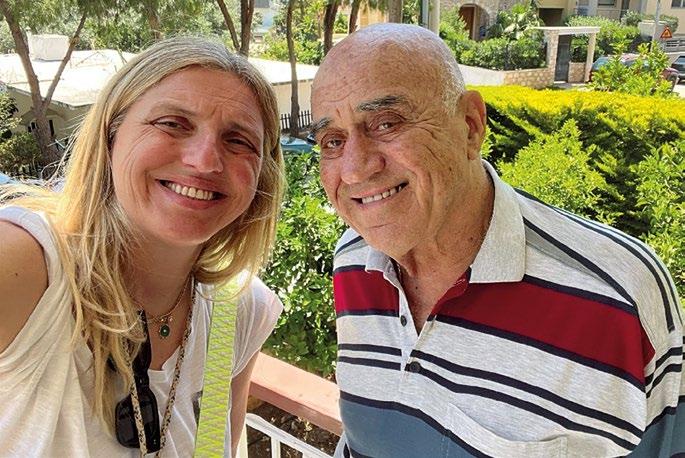 Introduced and compiled by Chara Markatzinou
C/O Oleksandr Stryzhov in CCR
Ms. Maria Malegou with her father George
Introduced and compiled by Chara Markatzinou
C/O Oleksandr Stryzhov in CCR
Ms. Maria Malegou with her father George
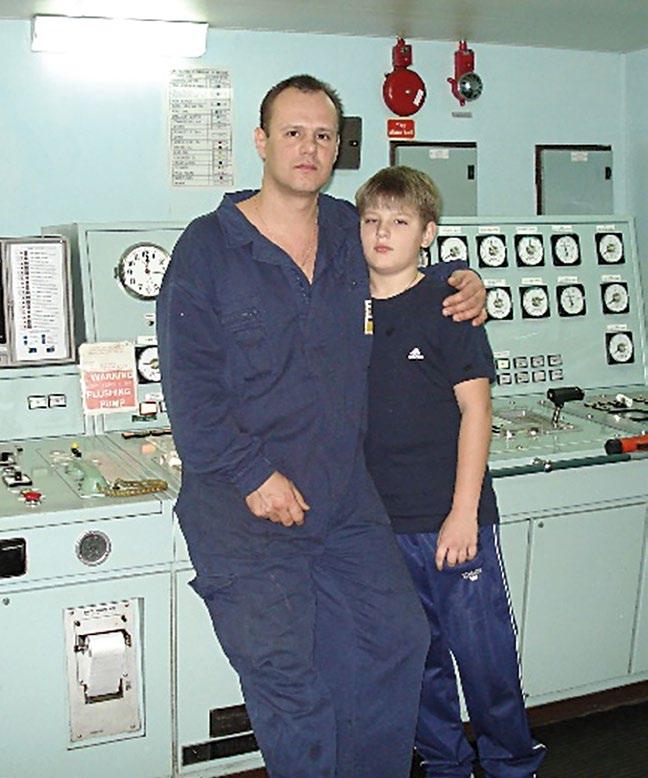
My parents are role models for me. They are both seamen. They met on the passenger ship "Shota Rustaveli". My mother worked as a waitress and my father was a motorman. They worked on several contracts together on the passenger ships "Shota Rustaveli" and "Ivan Franko". After they got married, my mother kept her maiden name so they could work together. As they say, it was the best time of their lives. My mother was already pregnant carrying me on her last voyage. I could say I became a seaman before I was born. After that, my mother ended her career as she devoted her life to raising my little sister and myself. My father continued his career, but on a tanker fleet. When I was 11 years old, I visited M/T "CE-MERAPI". She called at the port of Odessa. I remember that day very well, because it was very important in my life. I was very impressed by everything, especially the engine room. After that I realized I want to become an engineer. At the first opportunity, I entered the Kherson Maritime College and when I was 18 years old, I began my career on board M/T "PANAGIA ARMATA". I am grateful to my parents for their support and help to find my career.

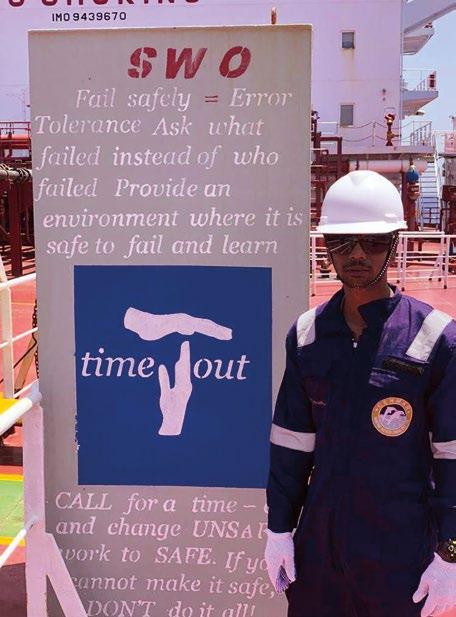
I somehow believe that these words can craft a man like Superman, not literally as a hero, but someone you can idolize and be proud of. Where in this world can I find him? Is he on land, in air or at sea? I know a man who is exactly like this and to be honest, I have already found him. Next to God, he is an iconic man every child wants to have. This man is undeniably my father, Fitter Thilagar KUMANAN. Living almost all of their life in the ocean away from their family has not been an easy task for most seafarers. Some retire, or worse some quit because of emotional effects brought by loneliness and the absence of their loved ones. Still, my father is different. He may miss us and want to be with us but still he never stops sailing and dreaming for us. He never lets his weakness bring him down to his knees. He is my greatest inspiration.
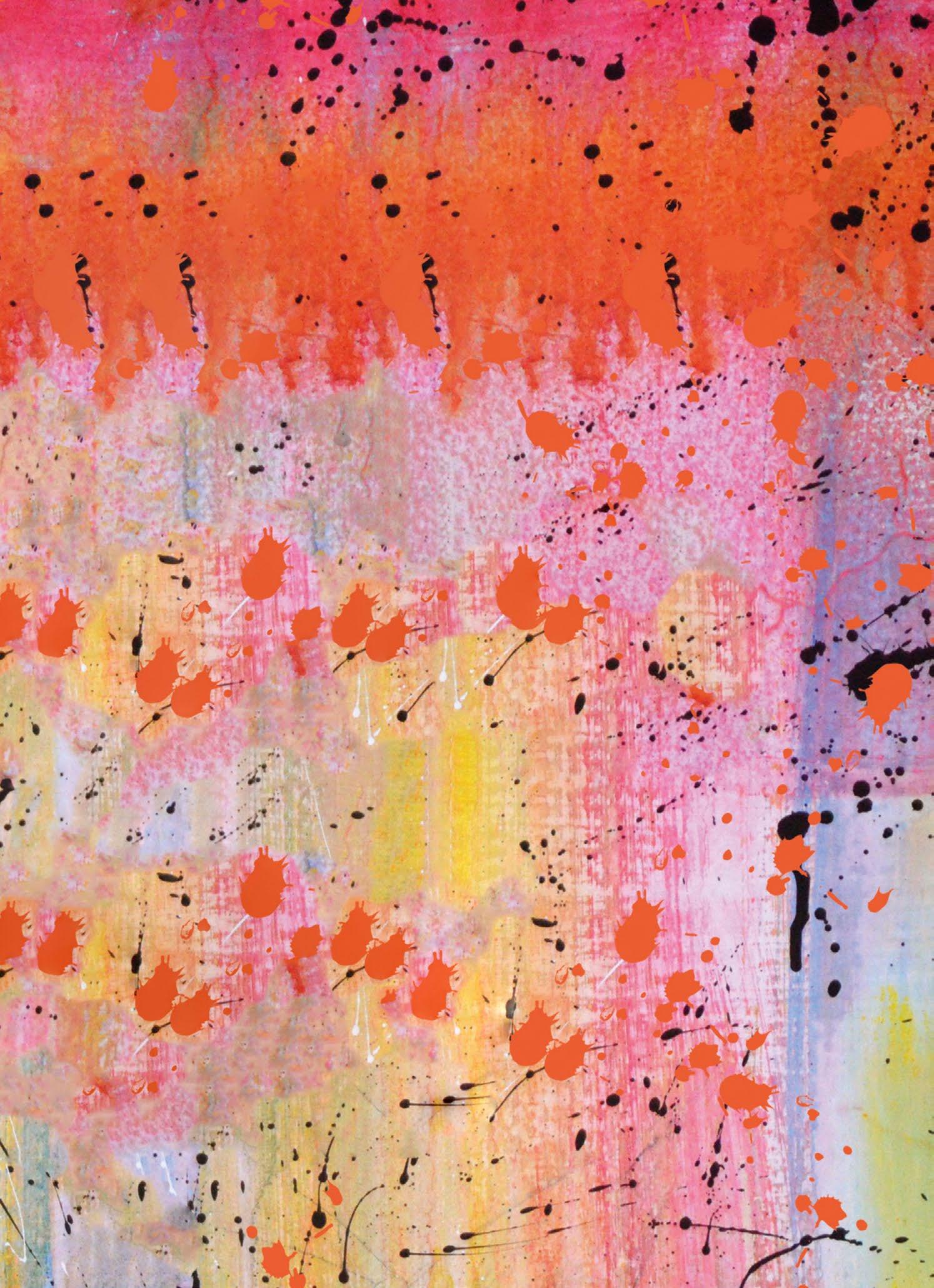
I am Sharon Kaye Jose, 43. I started working with CENMAR way back in June 2006. Through the years, I have seen how the Company has evolved and helped many of the seafarers to grow and realize their dreams. As a single mom, I dreamt of giving my own son, Michael Angelo Jose, the same kind of fortune that these seafarers gained. I used to tell my son about the success stories of my seafarer friends. I also told him that working in a shipping company may not be easy but the rewards will be great. Inspired by my story, he took Maritime Studies in college. He graduated in 2016, then had his cadetship and finished it the year after, ready to sail. The first few months that my son and I were apart were very hard for me, considering it was the first time we had been away from each other, literally oceans and miles away. Thank God, we made it through. Our combined earnings helped us so much with our needs. Before we knew it, we have more than we could ever imagine. My son and I can now fulfill our greater goals, we never thought would be possible. As he starts to build a family of his own, he has now the resources to get all the basic needs and let his future kids live a wonderful life. Everything is now falling into place. My son’s hardships are finally paying off and I can say it was all worth it convincing him to follow this path.
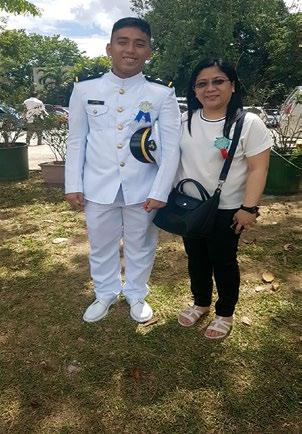
“If you can’t fly then run, If you can’t run then walk, If you can’t walk then crawl
But whatever you do you have to keep moving forward.”
Martin Luther King Jr.
3rd Mate JUATON CharlesAs a young man, I envisioned myself working in the corporate world, but as I grew older, my father, Edgar Juaton, who is currently working in the office of Cenmar as Training Manager, inspired and motivated me to pursue my seafaring career. I have seen his passion and dedication towards his profession, enabling him to provide a pleasant life for us. He has been in the industry for almost 30 years. He has 18 years of experience in various companies, and spent the last 12 years with CENMAR. He, as well, started at the bottom and worked his way up through commitment and perseverance. I have learned a lot from him. He taught me everything I needed to excel and was able to share his knowledge and experience. Having the same profession is beneficial. I have witnessed his entire journey and I have always wanted to follow his steps. I studied at PMMS and took a BS in Marine Transportation. In 2012, I started my maritime career as a utility at CENMAR ManiIa. When I had the opportunity to embark at CE-MERAPI as a cadet in 2013, I worked tirelessly and never stopped learning. Finally, all the hard work paid off. I was promoted to Able Seaman in 2014 with the help and guidance of my senior officers and colleagues. I realized that my journey had just started and I aimed at becoming an officer. In 2019, I decided to take it to the next level and take the officer’s examination, which I fortunately passed and obtained my license. In addition to that, my primary aspiration was to give my family a decent life, particularly my mother, in return for all the sacrifices she has made for all of us. I hope I have made her proud. Being a sailor is never an easy job. Being miles apart from your loved ones can be disheartening. It is not just about making money and meeting new people. It is also about having an extended family who will help and support one another during difficult times. It is also about sharing and gaining knowledge. To succeed, you must have strong work ethics, professionalism, perseverance, patience, adaptability, and flexibility. It is quite difficult and challenging, but it is all worthwhile and rewarding.
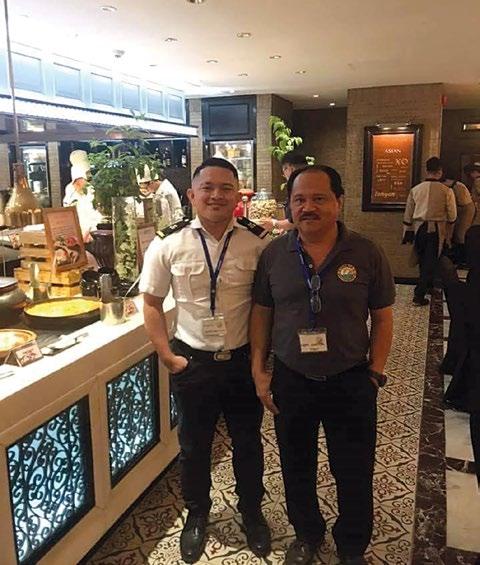
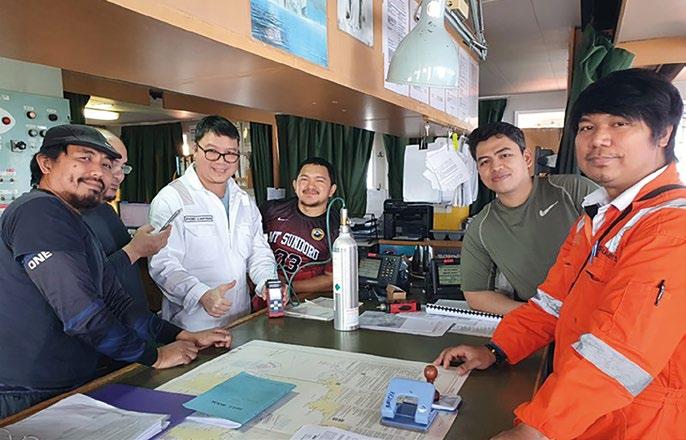
I am forever grateful to be part of the Company for a decade now, and I owe it all to you, Lord. I am what I am today because of my superiors and fellow employees. Thank you for all the help, opportunities, and trust you have given me. I pledge to perform my duties and responsibilities to the best of my ability, to be an inspiration, and to be an asset to the Company. CENMAR values not only its employees but also their families.
‘’Coming together is a beginning. Keeping together is progress. Working together is a success."
 ASD JUATON Edgar Charles on M/V Apageon being trained by our SBTRN Capt. Rommel REYES
ASD JUATON Edgar Charles on M/V Apageon being trained by our SBTRN Capt. Rommel REYES
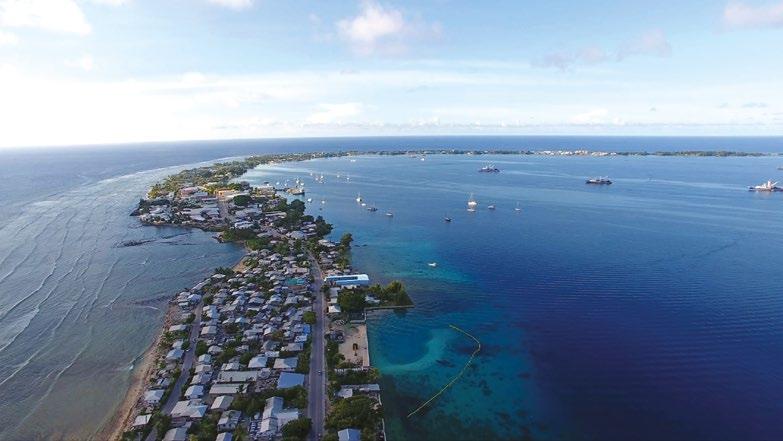
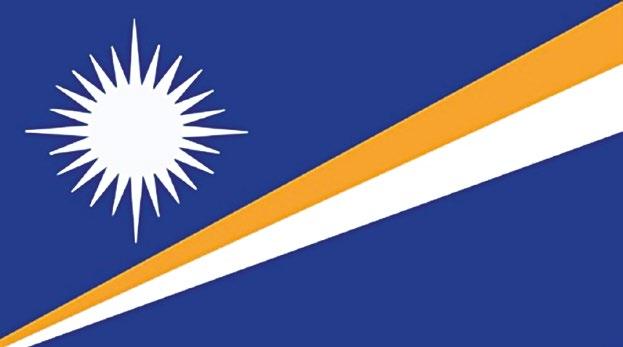
A cursory glance at a map of eastern Micronesia will, in all probability, reveal little to those without knowledge of the region. Those familiar with settlements in the Pacific Ocean, however, will be aware of the presence of over 1200 islands, islets and atolls scattered over hundreds of thousands of square miles that make up the Republic of the Marshall Islands.
The Shipping Registry of the Republic of the Marshall Islands is the world’s fourth largest in terms of the number of vessels it handles. This incredible statistic, in light of the country’s geographical location and prominence, has been achieved due to the significant growth it has experienced since the beginning of the millennium.
The majority of the nearly 3800 vessels now on the books are either bulk carriers (37%) or tankers (35%). As regards the number of vessels registered by nationality of ownership, Greece tops the list with just under 30% of the total. The US, Norway and South Korea round out the top four in that order. The rise to fourth largest registry has been driven by high quality service. This is reflected by a commitment to providing full support from any of the 28 offices at any time of day or night and the recognition the Republic’s registry has received. One example is the Registry having maintained a continuous presence on the White List Status of both the Paris and Tokyo Memorandums of Understanding (MoU). Other examples include meeting the flag criteria for a low risk ship under the Paris and Tokyo MoU’s New Inspection Regimes, and qualifying for the US Coastguard’s Qualship 21 roster for an unprecedented 15 consecutive years.
Of all the specks of land scattered across a vast expanse of ocean, only 24 islands or atolls of the Marshall Islands are inhabited. About three quarters of the population, which numbers the same as that of a medium-sized town in the UK, live on the atolls of Majuro (the capital) and Kwajalein (the largest at 65 square miles (168km2)). The rest, who live in traditional villages on the outer islands, are primarily engaged in subsistence farming and fishing. The major crops are bananas, coconuts, pandanus, breadfruit and taro. Pigs and poultry are also raised on farms.
The Marshall Islands were administered by the US as part of the Trust Territory of the Pacific Islands from 1947 to 1986, when it was dissolved by the US Government. Following the dissolution, the ties between the Republic and its former administrators remained strong, which is further evidenced by the fact that the US dollar is the official currency of the Marshall Islands.
Majuro: The Capital of the Marshall Islands. Courtesy of: www.wikimedia.org
The Marshallese are a seafaring people who are skilled at navigating the atolls, which are richly coloured by flowers like flame of the forest, hibiscus and plumeria, the National Flower. Their skills are not only useful for the Islanders who need to travel around the country but also for international visitors. At the top of the list of reasons to visit the Marshall Islands is diving. Known as a diving hotspot, the region is a magnet for intrepid divers wishing to explore wrecks from WWII.
Another reason concerns the wildlife. On the reefs formed by some 160 species of coral, there is a plethora of colourful fish for divers to feast their eyes on. Other marine creatures that can be seen are dolphins, turtles, sharks and four species of whales. Birdwatchers are also attracted to the Marshall Islands, where over 70 species, including the Micronesian pigeon, can be spotted. For those visitors who seek beautiful beaches, the Marshall Islands will not disappoint as pristine locations like Laura Beach have been described as a ‘slice of paradise’.
Flame Angelfish, one of the colourful inhabitants of the Marshall Islands reefs. Courtesy of: en.wikipedia.org
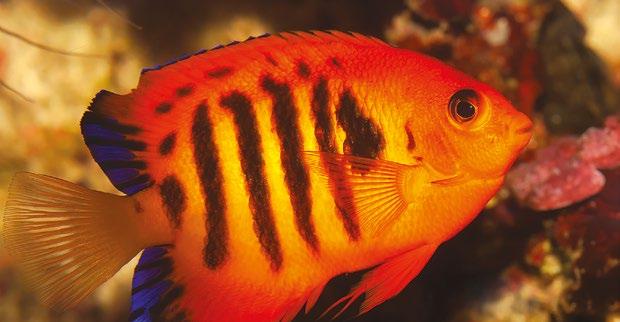
The Marshall Islands may consist of low-lying atolls, none of which rises 20ft (6m) above sea level at high tide, have a small population and be remote, but the country is certainly not off the map. As the world’s fourth largest shipping registry, the Republic of the Marshall Islands has gained the type of visibility that eludes much larger nations.
Sources: www.hbs.unctad.org, www.register-in-iri.com, www.britannica.com, www.worldtravelguide.net, www.pbif.org, www.rnz.co.nz, www.terralingua.org
Founded in 2018, the Sea Women of Melanesia began their conservation work in the Solomon Islands and Papua New Guinea to address a threat to the local fisheries industry created by rising populations and increasing levels of waste. As villagers living in these two countries are dependent on fish as a major food source, they sought to maintain fish numbers at levels that will continue to provide for the local population in future.
close to their villages that lie in marine protected areas.
When problem areas are located, local knowledge combined with scientific research findings provides enough information for the conservationists to oversee restoration work on the reef. In addition to the trained women becoming part of a vital conservation effort, the communities in which they live have witnessed their social standing rise to a new level. Such has been the impact of the Sea Women’s work that in 2021, they received the UN’s highest environmental award in the Inspiration and Action category. After receiving the award, the Sea Women of Melanesia expressed their gratitude for the recognition they have been given and their hope that the award will inspire others to join the movement in order to make the world a better place.
Champions of the Earth: The Sea Women of Melanesia


Source: www.news.un.org
Given the vast expanse of ocean covering their area of operation which is part of the Coral Triangle that extends from the Great Barrier Reef and the Melanesia archipelagos to South East Asia, the founders realised that the group alone could not achieve their aim. Even with the 40 or so members who make up the Sea Women of Melanesia today, monitoring all the fish habitats is an impossible undertaking. As a consequence, the Sea Women, who are accomplished divers, surveyors and photographers, have taught numerous women how to identify areas of concern in reefs
This tasty Greek dish got its name from the shape of its base. The word ‘papoutsaki’ translates as ‘shoe’, which is what half an eggplant that has been cut lengthwise looks like. On the eggplant there is a stuffing and to top the meal there are ingredients that place the dish in the comfort food category.
The first step of the recipe involves scoring the cut eggplants in a zig zag pattern, which helps the cooking process and results in a better marinade with salt, pepper, thyme and olive oil. Once the marinading ingredients have been added the eggplants are baked with the skins facing upwards.
While the eggplants are baking, the stuffing is prepared in a hot pan. A mixture of garlic, onion, olive oil, sugar, cinnamon and cloves are caramelized until golden brown. Then salt and pepper are added along with thyme to ground beef or lamb before it is placed in the pan. When the meat is brown, red wine is added. This deglazes the pan and adds flavour. When the alcohol in the wine has evaporated, tomato sauce is added. The ingredients are then cooked while stirring until there is no water left in the stuffing.
The baked eggplants are then turned over ad space is made for the stuffing by gently moving the flesh away from the centre. Cheese and herbs like parsley, mint and thyme are then added to the stuffing before being placed in the eggplants with a spoon. At
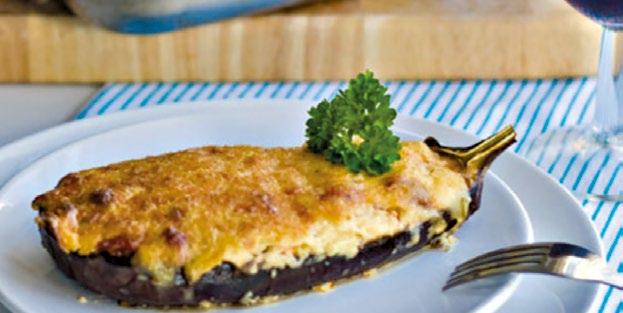
The award is of particular significance as it is the first in the UN Decade of Ecosystem Restoration (2021-2030), which aims to prevent, halt and reverse the loss and degradation of ecosystems worldwide. This United Nations General Assembly initiative is an urgent global appeal to revive damaged ecosystems so that we can combat climate change and prevent major loss of life.
Sources: www.news.un.org, www.youtube.co, www.decadeonrestoration.org
Source: www.syntagesmekefi.gr
this point there are two alternative toppings to finish off the dish. The first is grated cheese and the other is béchamel sauce.
The latter, which probably places papoutsaki further into the comfort food category was the contribution of the world famous, Sifnos-born, Greek chef, Nikolaos Tselementes. After the béchamel topping has been added, the papoutsaki goes back into the oven until it is golden brown. With the grated cheese topping, the dish is ready when the cheese has melted.
Papoutsaki may be described as a rich dish given the amount of dairy produced used, but it is surprisingly light. If a vegetarian version is preferred, then a substitute for the ground beef is diced sautéed mushrooms with carrots and celery. A potato based puree can also be used as an alternative topping.
Sources: www.thegreekfoodie.com, www.youtube.com, www.mygreekdish.com, www.theculturetrip.com
During the late 1970s prospectors looking for alluvial gold near the Masao River in Butuan came upon the remains of nine boats. Scientists were informed of the finds, and through carbon dating methods, they discovered that the prospectors had discovered the oldest known balangay boats, a type of boat that was used throughout the Philippines as a trading vessel before the colonial era began.
It could be argued that the discovery of what became known as the Butuan boats rekindled an interest in these incredible boats. Of the nine buried vessels, three have been recovered. The first, which was carbon dated to 320 AD, is now housed in the Balangay Shore Museum. The second, which dates back to 1250 AD, can be seen in the Maritime Hall of the National Museum in Manila, while the third is still undergoing preservation. The balangay boats that plied their trade among the Philippine islands in the pre-colonial era bore a resemblance to the boats of the Austronesian peoples. Made from tropical hardwood, the dugout keel had ribs and planks that were bound together by fibre lashings. The planks were held together by using holes and dowels in a manner true to early boat-building methods. Balangay boats also had a prow and sternposts that were made from single carved pieces of wood. The Butuan boats differed from the later versions in that their keels consisted of a central plank fitted with these parallel lines of thin lugs that served as lashing points.
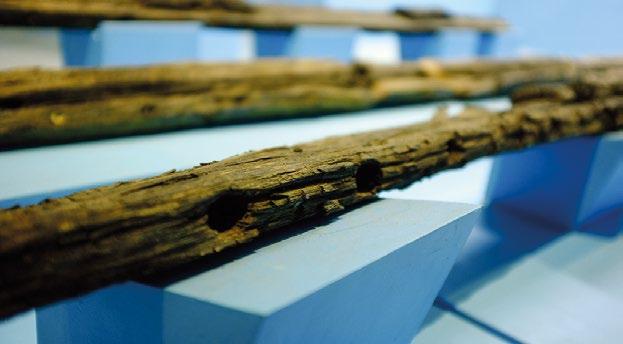
methods adopted by the earliest sailors who used the sun, stars, wind, cloud formations, wave patterns and bird migrations to set their course. As regards aims, there were two main ones. One was to build goodwill. This involved the Diwata ng Lohi sailing across South-East Asia to Brunei, Malaysia, Indonesia, Singapore, Thailand and Vietnam. During the 17-month-long voyage, the expedition enhanced awareness on marine and coastal protection, provided medical assistance to poor coastal communities, taught disaster preparedness, helped protect endangered coral reefs and planted mangrove trees. The other aim was to give pride to Filipinos through their maritime heritage, which was in danger of being largely forgotten. On the first leg of the voyage, Diwata ng Lohi was accompanied by two other balangay boats. As they sailed from Manila to Davao and then on to Sibutu and Sitangkai in Tawi-Tawi, they received sea support from the Philippine Navy and Coast Guard.
Planks from one of the Butuan boats in the Butuan National Museum showing the holes on the edges where dowels were inserted Source: www.wikipedia.org
Although the discovery of the Butuan boats sparked some interest in the country’s maritime heritage, its impetus was not maintained. This was recognized by the Kaya ng Pinoy (the Filipino Can) Foundation, which launched the Diwata ng Lohi project in 2009. This project involved building a balangay boat to be called Diwata ng Lohi in Manila. The responsibility for building the boat was given to native Badjao boat-builders from the southern province of Tawi-Tawi. These skilled builders used traditional methods and traditional tools such as a cutting tool called an adze and hammering tool called a pakang. Though the craftsmanship and materials were faithful to those used in ancient times, the reconstruction was not an exact replica as there was no outrigger. The decision not to have one may have been influenced by the fact that no outrigger on the Butuan boats had been preserved, so there was no record of exactly what it looked like.

The primary objective of the Foundation’s project was to retrace ancestral voyages in a balangay constructed using ancient methods. Navigation was also to remain accurate to those
Four years after the successful completion of the goodwill voyage, the balangay was declared the National Boat of the Philippines. This declaration was made so that the country’s great maritime tradition would be recognized by future generations of Filipinos. Moreover, it would allow Filipinos to appreciate the values of solidarity, harmony, determination and courage held by the maritime community.
The balangay boat, or rather two of them, also played a part in the 500-day countdown to the 500th anniversary of the Victory at Mactan. They set sail from Palawan across the Sulu Sea to Butuan, where they were joined by representatives from Butuan City, and on to their destination of Cebu-Mactan. That symbolic voyage took place in December 2019. On a more permanent basis, the balangay takes centre stage in the annual Balanghai Festival that is celebrated in Butuan City. The highlight of the celebration is a re-enactment of early migrants landing at Butuan in balangay boats.
The story of the balangay since the fortuitous discovery of the Butuan boats is inspiring. It highlights the effort required to revive a largely forgotten maritime legacy so that it once again becomes a symbol of national identity and reignites an appreciation of ancestral endeavours. Moreover, it shows how those governmental agencies, prominent organizations and committed individuals who recognize the importance of cultural heritage can work together towards a common goal and achieve it.
Sources: www.goodnewspilipinas.com, www.imao.ph, www.en.wikiphilipinas.org www.maritimeasia.ws, www.durianburgdavao.com, www.dbpedia.org
Representing 0.82% of the world’s ocean surface, the Mediterranean Sea covers around 970,000 sq. miles (2,500,000 sq. km). According to geological research the body of water was cut off from the Atlantic Ocean some 5.9 million years ago, and without a major inflow, dried up over the following 600,000 years. Then came the Zanclean flood, which refilled the ‘basin’ around 5.3 million years ago.
With an average depth of 4,920ft (1500m) and a maximum depth of 17,280ft (5267m), the aptly named Sea is almost completely surrounded by 21 countries. The countries that border the Mediterranean Sea (in alphabetical order) are: Albania, Algeria, Bosnia and Herzegovina, Croatia, Cyprus, Egypt, France, Greece, Israel, Italy, Lebanon, Libya, Malta, Monaco, Morocco, Palestine, Slovenia, Spain, Syria, Tunisia, and Turkey. This body of water also encompasses more than 3300 islands, the two largest of which are Sicily and Sardinia.

Being almost surrounded by land, the inflows to the Mediterranean are rather narrow. Fresh water reaches the Mediterranean Sea from several rivers, the largest of which are the Nile, Ebro, Rhone, Chelif and Po. Saltwater arrives from the Atlantic through the Strait of Gibraltar and from the Sea of Marmara via the Bosporus Strait. These inflows determine the main currents, which flow counter clockwise in this body of water. As the rivers only replace 35% of water lost through evaporation, there is a continuous inflow from the Atlantic passing eastward along the north coast of Africa. This surface current is strongest during the summer months, when evaporation is at its greatest. This inflow together with that from the Bosporus increases the salinity of the water, which sinks as its density is greater. Thus, a subsurface current that flows westward to the Atlantic is created.
Because the levels of nutrients in the surface water of the Atlantic are low, the nutrient levels in the Mediterranean are comparatively low. Despite this, the Mediterranean Sea is home to a rich diversity of marine life. Demersal species (bottom-living) such as hake, sole, flounder, turbot, whiting, red mullet, and sea bream as well as pelagic (upper-layer) species like bluefin tuna, mackerel, bonitos, anchovy and sprat are fished on a commercial scale. Indeed, commercial fishing in the region is very important as sea food is in high demand across the nations that border the Mediterranean Sea.
The high demand for fish has put pressure on stocks due to overfishing. The result has been a widespread depletion of several species and higher prices for fresh fish. This situation has favoured small scale fishing operations taking place over short trips. The less efficient larger vessels have tried to compensate by using long
trawl nets of small mesh size to maximise their catch. It is a strategy that has increased catches, but it has also led to non-commercial species like dolphins, turtles and the endangered monk seal being trapped in the nets. There are, however, several agencies working to relieve the pressure on stocks. Among these is the WWF, whose main aim is to implement long-term management plans for all fish stocks so that they can recover and any negative impacts on other species and ecosystems can be kept to a minimum. With over 450 ports and terminals, the Mediterranean Sea is one of the world’s busiest sea lanes, accounting for about 15% of global shipping activity in terms of the number of calls made. The busiest ports in the Mediterranean are Piraeus, Valencia, Algeciras, Genoa, Mersin and Alexandria. In addition to cargo vessels, the Mediterranean Sea caters for a large number of cruise ships. Indeed, as the 2nd largest cruise region in the world, the Mediterranean accounts for around 15% of the world’s global cruise fleet deployment. The top cruise ports are Barcelona, Piraeus, Marseille, Naples and Dubrovnik. Marine traffic is also augmented by leisure craft for which there are some 400,000 berths, making the region home to one of the largest recreational boating and large yacht fleets in the world.
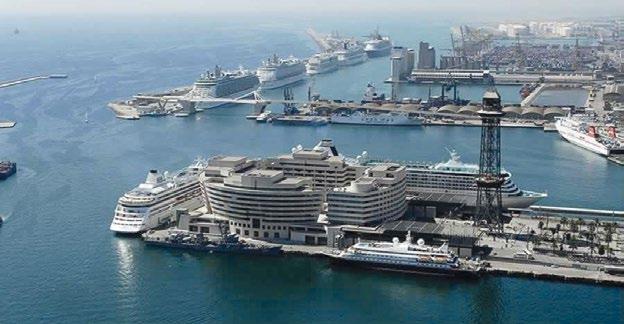
Maritime activities, tourism, industrialisation and population increases in coastal areas have put the Mediterranean under mounting pressure. The good news is that the threats to the health of the region were identified and action was begun to address the problems nearly half a century ago, when the United Nations Environment Programme, (UNEP) was set in motion. Additionally, in 1975, the Mediterranean Action Plan (Med Plan) was adopted by 16 countries. This plan had four components: legal measures, institutional and financial support, integrated planning to prevent environmental degradation and the coordination of pollution monitoring and research. Of the legal measures the two most important are the Barcelona Convention (1976), which was concerned with protective action against all forms of pollution, and the Athens Protocol (1980), which required the adoption of programmes to prevent and control pollution from land based sources.
More recently, such programmes as the Western Med initiative, the EU strategy for the Adriatic and Ionian region (EUSAIR) and the Union for Med, which focuses on the blue economy, have been implemented. Hopefully, these and similar programmes will help maintain the health of this very special region that has been described as the ‘Cradle of Civilization’.
Sources: en.wikipedia.org, www.britannica.com, www.marineinsight.com, www.wwfmmi.org www.oceans-and-fisheries.ec.europa.eu, www.panbleu.org, www.grida.no, www.docksofthefuture.eu
1. Make the names of two countries using all the letters in the following sentence: I CANNOT MOURN MEERKATS.
2. The letters in the chemical (symbols for antimony, europium and rhenium can be arranged to form the name of a historic vessel. What is the name of the vessel?
3. I can be used to make a measure of speed, and sometimes a large dog’s collar or lead. I can be found on ships and boats, and I can be used to tether goats. What am I?

4. Which three-letter word can be used to complete the following words: GAL_ _ _IC, RE_ _ _OR, F_ _ _UAL, B_ _ _ERIA?
5. Harold likes to stay in shape, and prides himself on being fit. He enjoys weightlifting and rafting. He likes travelling and wants to visit South Africa and Afghanistan. His favourite bird is the
1. The Can test to evaluate possible flow of loaded cargo involves striking a can half full of cargo on a hard surface. How many times should this process be repeated?
A. 5 B. 15 C. 25 D. 40
2. On what date is the International Day for Women in Maritime? A. 18th May B. 23rd May C. 30th May D. 5th June
3. What type of additive manufacturing is mostly used in the maritime industry?
A. powder bed fusion B. material jetting C. sheet lamination D. binder jetting
4. How much longer did the Suez Canal become following the 2015 project to lengthen it?
A. 10km B. 16km C. 23km D. 29km
5. Who sailed across the Pacific on the Kon-Tiki in 1947? A. John Voss B. Magnus Andersen C. Lief Eriksen D. Thor Heyerdahl
6. Mandvi is well known for dhow-building. In which Indian state is Mandvi located?
A. Kerala B. Gujarat C. Maharashta D. Karnataka
fairy tern and his favourite breed of dog is the Norfolk terrier. His favourite dish is moules frites. By the same token which fruit does he prefer: grapefruit or pineapple? Why?
6. Which four-letter word can be placed after the words to the left and before the words to the right?
7. In 5 steps change the word WENT to GONE by changing one letter at a time to form intermediate words.

8. What is the next number in the following sequence: 4, 8, 14, 24, 40, 66, 108, X ?
7. In which American state is the Queen Mary now permanently moored?
A. Virginia B. Florida C. California D. Washington
8. Company Health & Safety Campaign was launched in December 2020, requestingsafety suggestions from fleet vessels. From which Company vessel was the top best practice received?
A. M/T Mikela P. B. M/T Pserimos C. M/T CE-Hamilton D. M/V Andonis
9. According to the UNCTAD Handbook of Statistics 2021, what percentage of global shipbuilding occurred in China, the Republic of Korea and Japan in 2020?
A. 84% B. 87% C. 90% D. 94%
10. Vasa, a 17thcentury Swedish warship, sank shortly after beginning her maiden voyage. What caused her to sink?
A. the Captain’s incompetence B. her instability C. enemy fire D. a severe storm
Answers at the foot of the page Answers at the foot of the page
8.Marshall
AmaliaM.5.Foul6.Mumbai
Context2.Butuan3.Lebanon
answers:
9.D10.B
QUIZanswers: 1.C2.A3.A4.D5.D6.B7.C
5.Grapefruit-allhischoices containthelettersthatspellfit:F, IandT.6.Stop7.BENT,BEND, BOND,BONE,GONE8.176
1.Cameroon,Turkmenistan2. Erebus3.Rope4.ACT
TESTYOURBRAINanswers:
InNovember 2012, Salvador Alvarenga went fishing off the Pacific coast of Mexico in a 25-foot (7.6m) boat. He was accompanied by Ezequiel Cordoba, an inexperienced seagoer who was standing in for Alvarenga’s regular fishing partner. Fishing was exceptional in the favourable weather, but on the second day, the wind started to pick up. As the fishing was so good, Salvador Alvarenga took a calculated risk and continued fishing, thinking that the weather would not deteriorate. It was a gross miscalculation.
The choppy seas and moderate winds quickly turned into a full-blown storm, prompting the authorities to prevent all fishing boats from going to sea. High waves began to dump large quantities of water into the boat, which had no raised structure or lights, making it virtually invisible on the surface. Mr. Alvarenga realised that he and Mr. Cordoba were in dire straits. He immediately set a course for the shore while he contacted the authorities, but he could not give them his precise location because the GPS, which was not waterproof, had stopped working. Then his radio, which only had a half-charged battery, died. A little while later, he spotted a mountain on the horizon. It gave him hope as he estimated that the boat was just two hours from land, but this faded when his motor broke down.
Without a radio, GPS or motor, the two men were at the mercy of the waves. Water continued to splash into the boat, rendering it less stable. In order to regain stability, Salvador Alvarenga decided to ditch their two-day catch, ice and extra gasoline. These actions rectified the immediate problem, but the two men had to bale water continuously to stay afloat. As the storm gradually relented, the fishermen gained some respite. Exhausted and very cold, they got under the well-insulated Styrofoam ice box, which was about the size of a refrigerator, to get warm and rest.
The storm had blown the boat way off course, so Alvarenga had no idea where they were. What was apparent, though, was that they were very hungry.
In desperation he used his hand to grab fish, passing those he caught to Cordoba, who cleaned them, cut them into strips and left them to dry in the sun. Of course, fish were not always available so they were not always able to satisfy their hunger. The same applied to their thirst, which they quenched to some extent with turtle blood and more effectively with rain that fell during a timely storm.
Being alone instilled fear into the lone survivor at first but he avoided spiralling into despair by creating alternative realities. He would imagine dining at the best restaurants and having a companion on the boat. He also managed to look on the bright side whenever he failed to get the attention of a passing ship. He remained in his make-believe world for months on end until a favourable current set him on a course for a tiny tropical island.
Source: www.theguardian.com
As he approached Tile islet, part of the Ebon Atoll located in the south of the Marshall Islands, he spotted shore birds. Eventually, he clambered onto the shore. He could barely stand, but fortunately for him, he had washed up near a beach house whose two occupants spotted him. They took him in, thinking he had fallen overboard from a passing vessel. However, seeing that he was virtually skin and bones, they knew that this was not the case. The couple summoned help from the police and a nurse who arranged for his immediate transfer to the nearest hospital. In hospital, Mr. Alvarenga was able to tell his story, the first part of which was confirmed by his supervisor. He had set out on 17th November 2012 and landed on Tile islet on 30th January 2014. In those 438 days, his boat covered 6,700 miles (10,782 km). His physical condition also bore witness to his ordeal. Indeed, he was in such a bad state that despite medical attention, his condition began to deteriorate. Fortunately, his condition was stabilized and he was discharged eleven days later.
Salvador Alvarenga receiving assistance on his way to hospital
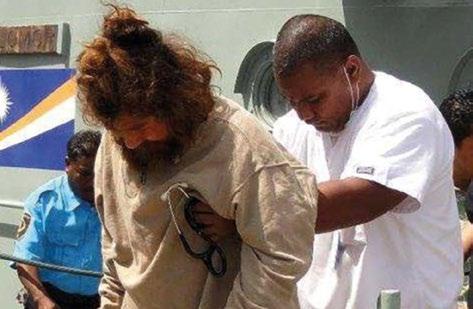
About a month into their ordeal, they came across plastic garbage. They gathered empty bottles to catch rainfall and found food items in plastic bags. Despite the food being of dubious quality, they ate it along with anything they caught or ended up on board like flying fish. They then began talking about their families and promised each other that if only one survived, he would visit the other’s mother. They seemed to be coping, but a month or so later, Ezequiel Cordoba had an adverse reaction to what he was eating. He began to fear his food and refused to eat or drink. He passed away shortly afterwards, leaving Salvador Alvarenga on his own.
Source: www.businessinsider.com
Salvador Alvarenga's survival story attracted widespread media attention. His return home was covered by the press, who were quick to point out that if he had not beached on Tile islet, he would not have reached landfall for another 2500 miles (4023 km). After he had regained sufficient strength, 36-year-old Salvador Alvarengo honoured his promise to meet Ezequiel Cordoba's mother.
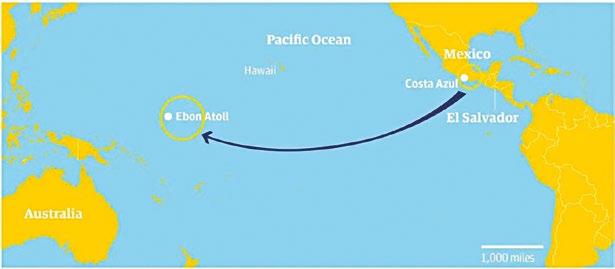
The fisherman's story highlights the importance of adapting psychologically to stressful situations, and how fortune as well as belief systems play a pivotal role in survival situations. It also indicates that survival does not end with a rescue. Following treatment, Salvador Alvarenga needed company 24 hours a day, could only sleep with the lights on and was left with a lasting fear of the ocean.
Sources: http://www.theguardian.com, http://www.slate.com, http://www.youtube.com